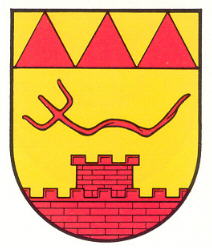Oberweiler im Tal: Difference between revisions
Jump to navigation
Jump to search
Knorrepoes (talk | contribs) m (Text replacement - "/Arms of " to "/Arms (crest) of ") |
Knorrepoes (talk | contribs) m (Text replacement - "{{media}}" to " {{de1}} {{media1}}") |
||
| Line 24: | Line 24: | ||
The arms show a kind of tool, officially described as a Geissel, a kind of whip. The whip and the three points in chief already appear on the only known seal of the village. The meaning and origin is not known. The base refers to the castle in the valley. The colours are those of the Counts of the Rhein (Wild und Rheingrafen), to whom the area historically belonged. | The arms show a kind of tool, officially described as a Geissel, a kind of whip. The whip and the three points in chief already appear on the only known seal of the village. The meaning and origin is not known. The base refers to the castle in the valley. The colours are those of the Counts of the Rhein (Wild und Rheingrafen), to whom the area historically belonged. | ||
{{ | |||
{{de1}} | |||
{{media1}} | |||
[[Civic Heraldry Literature - Germany|'''Literature''']]: Debus, 1988 | [[Civic Heraldry Literature - Germany|'''Literature''']]: Debus, 1988 | ||
Revision as of 11:19, 26 December 2022
This page is part of the German heraldry portal |
Heraldry of the World |
|
German heraldry:
|
Selected collector's items from Germany:
|
OBERWEILER IM TAL
State : Rheinland-Pfalz
District (Kreis) : Kusel
Verbandsgemeinde : Verbandsgemeinde Lauterecken-Wolfstein (until 2014 Verbandsgemeinde Wolfstein)
| German | Unter gold-rotem Zick zackschildhaupt in Gold, über einer wachsenden roten Zinnenburg mit rotem Zinnenturm eine rote Geißel. |
| English | im Tal No blazon/translation known. Please click here to send your (heraldic !) blazon or translation |
Origin/meaning
The arms were officially granted on March 21, 1983.
The arms show a kind of tool, officially described as a Geissel, a kind of whip. The whip and the three points in chief already appear on the only known seal of the village. The meaning and origin is not known. The base refers to the castle in the valley. The colours are those of the Counts of the Rhein (Wild und Rheingrafen), to whom the area historically belonged.
Literature: Debus, 1988


